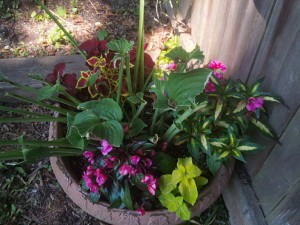
There are some commercial locations that just seem jinxed. Businesses move in, last for a year or so and then die, only to be replaced by other businesses that repeat the pattern, sometimes for years on end. I have a garden bed like that. Every year I try to find a perfect landscape solution for the area and every year the results disappoint me. I am giving it another try in an effort to make horticultural hope triumph over situational experience.
The plot in question has definite pluses and minuses. I know the soil is decent, because weeds grow abundantly. In fact, if I allowed it, English ivy would take over the whole thing. On the other hand, it is shaded by the neighbors’ large oak tree, so sun-loving plants are not an option. The bed is regularly browsed by the local deer herd, whose denizens savage the hostas and nibble large New Guinea impatiens down to the ground. The oak tree also drinks up most of the available moisture, so if I want anything to grow during drought times, I have to water liberally.
But this year I aim to make a concerted effort to get it right. Since inspiration generally strikes when I am weeding, the first job is a good clean-out. The array of weeds is impressive. My neighbors’ unstoppable wisteria long ago leaped the bounds of their property and keeps intruding on mine, snaking along the ground, scaling fences and popping up in unexpected places. Every year I pull out scores of linear feet in an effort to keep it under control. I will do it again this year, making an especially aggressive effort.
Perilla mint, which can probably grow equally well in the Amazon basin or the crater of an active volcano, also thrives in my dark corner. I will keep a few stands of it for color and banish the rest.
I need tall plantings to give the bed depth. This is a problem because shade plants are often low growers. One exception to this rule is the oakleaf hydrangea—Hydrangea quercifolia. I have a large one on the opposite side of the back garden and it has given birth to a robust offspring that is now about a foot tall. I could transplant Quercifolia Jr. in the hopes that it would eventually reach the same six to seven foot height of its parent, but that process would take a few years.
Since near-immediate gratification is a necessity for garden trouble spots, I will buy one of the dramatic, part-shade loving giant elephant ear plants—Alocasia–and position it where the need for height is greatest. By mid to late summer, it will have grown to a significant size, providing a striking backdrop for the rest of the plants. Once I have taken care of that, I can also pot up Quercifolia Jr. and plant it in the fall when I take up the giant Alocasia bulb for storage.
My shade bed also needs a color infusion. I have already planted riotously colored coleus in a big pot that used to be home to a giant, blue-leafed hosta. Unfortunately Mr. Antlers, or some of his ravenous family, ate those great big leaves and now there is nothing left but a collection of forlorn-looking stalks. By a week or two from now, the coleus, assisted by a healthy amount of deer spray, will grow big enough to camouflage those wretched remains. I can plant other coleus in an array of large and small pots and drop them into empty spaces.
Deer never touch foxglove or Digitalis because it is toxic, so I will increase my foxglove inventory. Foxglove is a notorious self-seeder, so investing in about five foxgloves will ultimately yield a great deal more. I’ll underplant them with Geranium sanguineum, also known as “bloody cranesbill” for its bright, red-purple flowers. It is a mounding, low grower that seems to do well in the front part of the bed. In the interest of thrift, I’ll simply divide my existing supplies. The fern-like, deeply dissected foliage is lovely even when the plants are not flowering. I have never known deer to eat it, though I suppose they might flatten it with their hooves on the way to tastier tidbits.
I would love to also plant additional Japanese painted fern or Athyrium niponicum ‘Pictum’, which features swirling gray-green leaves accented with burgundy or red. However, they take a great deal of water during dry periods and I confess to occasional bouts of irrigation irresponsibility. As low growers, the ferns might also be subject to deer depredation. The jury is still out.
So now, I will wait for the arrival of my elephant ear bulb and go about the business of cleaning out the ugly back bed, moving some baby foxgloves, dividing the hardy geraniums and propagating additional colorful coleus. The latter is so easy that even my seventeen year-old cat can do it. That is a good thing, since I will need all my available brain cells to outwit the deer.
